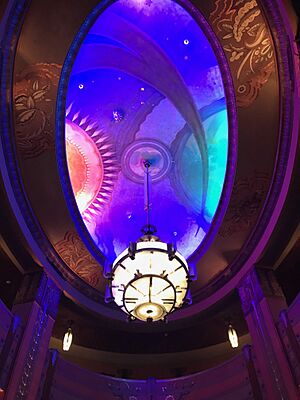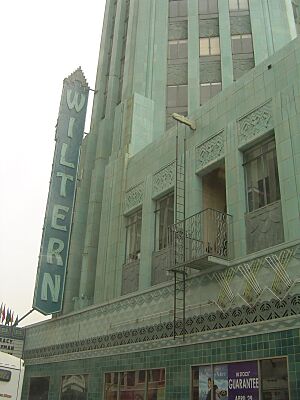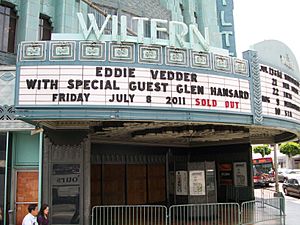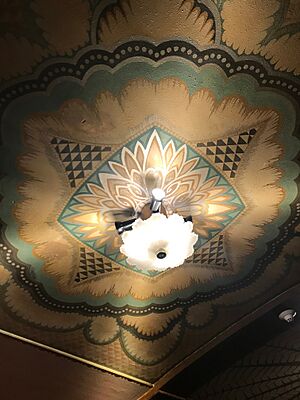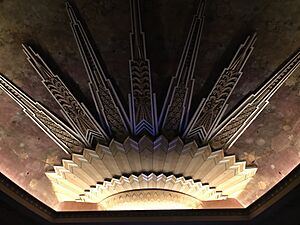Pellissier Building and Wiltern Theatre facts for kids
Quick facts for kids Pellissier Building and Wiltern Theatre |
|
|---|---|
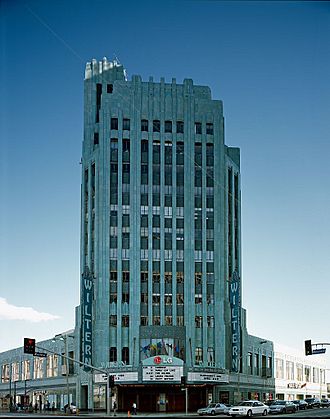 |
|
| Former names | Wiltern Theatre The Wiltern Center |
| General information | |
| Status | Complete |
| Type | Commercial offices cinema |
| Architectural style | Art Deco |
| Location | 3780 Wilshire Boulevard |
| Coordinates | 34°03′40″N 118°18′28″W / 34.0611°N 118.3078°W |
| Construction started | 1930 |
| Completed | 1931 |
| Renovated | 1983 |
| Height | 155 ft (47 m) |
| Technical details | |
| Floor count | 12 |
| Design and construction | |
| Architect | Stiles O. Clements G. Albert Lansburgh |
| Architecture firm | Morgan, Walls & Clements |
| Main contractor | William Simpson Construction Company |
| Other information | |
| Seating capacity | 1,850 |
|
Pellissier Building and Wiltern Theatre
|
|
| Built | 1931 |
| Architect | Stiles O. Clements G. Albert Lansburgh |
| Architectural style | Art Deco |
| NRHP reference No. | 79000488 |
| Significant dates | |
| Added to NRHP | February 23, 1979 |
The Pellissier Building and the Wiltern Theatre are famous landmarks in Los Angeles, California. This 12-story building stands about 155 feet tall. It is located at the corner of Wilshire Boulevard and Western Avenue. The whole place is often called the Wiltern Center.
The building is covered in shiny blue-green tiles. It is a great example of Art Deco architecture, a popular style from the 1920s and 1930s. The Wiltern building is privately owned. The Wiltern Theatre is managed by Live Nation, a company that puts on live shows.
Contents
Where is the Wiltern Theatre?
The Wiltern Theatre is in the Los Angeles neighborhood of Koreatown. It is on the southeast corner of Wilshire Boulevard and Western Avenue.
Getting there is easy because Koreatown has good public transport. The Wiltern Theatre is right across from the Wilshire/Western Station. This is a subway station for the D Line.
What Does the Wiltern Look Like?
The Pellissier Building is named after the family who owned the land. It is a 12-story office tower made of steel and concrete. The tower sits on a two-story base. This base has shops on the ground floor and the theatre entrance.
The building has tall, narrow windows that make it look even taller. This style is called French Zig-Zag Moderne. Buildings in Los Angeles could not be taller than the city hall until the late 1950s.
Inside the Wiltern Theatre
The entrance to the Wiltern Theatre has big, bright neon signs. Visitors walk on colorful terrazzo floors to reach the ticket booth. The inside of the Wiltern was designed by G. Albert Lansburgh. It is famous for its amazing Art Deco style.
You can see beautiful plasterwork, tiles, and colorful paintings by Anthony Heinsbergen. The most striking part is the sunburst design on the auditorium ceiling. Each ray of the sunburst looks like an Art Deco skyscraper. This was Lansburgh's idea of what Wilshire Boulevard would look like in the future. When it first opened, the Wiltern also had the biggest theater pipe organ in the western United States.
Both the Wiltern Theatre and the Pellissier Building are important landmarks. They are listed on the National Register of Historic Places. The City of Los Angeles also named them a Los Angeles Historic-Cultural Monument.
History of the Wiltern
The Wiltern was built in 1931. Architect Stiles O. Clements from Morgan, Walls & Clements designed it. It was first meant to be a vaudeville theater. It opened as the Warner Brothers Western Theater. The William Simpson Construction Company built the complex.
The theater closed a year later but reopened in the mid-1930s. It was then renamed the Wiltern Theatre. The name comes from the intersection it faces: Wilshire Boulevard and Western Avenue.
In 1956, the building and theater were sold. A group called the American Theater Organ Enthusiasts worked to fix the theater's large pipe organ. They held music shows there until the mid-1970s.
Saving the Wiltern
By the late 1970s, the Wiltern was in bad shape. The owners wanted to tear it down. But local groups who wanted to save old buildings stepped in. They stopped the demolition twice. Saving the Wiltern was one of the first big wins for the Los Angeles Conservancy. This group works to protect the city's old buildings.
In 1981, a developer named Wayne Ratkovich bought the Wiltern. He worked with architect Brenda Levin to bring the theater and office building back to life. They had successfully restored other buildings in Los Angeles. This made people believe they were the right team for the job.
The office building was finished by 1983. But the Wiltern Theatre was much harder to fix. It had not been cared for well. Many paintings and plaster decorations were damaged. Some parts of the ceiling had even fallen down. The theater was also used for a movie called Get Crazy, which caused more damage.
To restore the theater, skilled artists were needed. A.T. Heinsbergen, whose father painted the original murals, helped. They even found old Art Deco seats from another theater to replace missing ones. The Wiltern was originally a movie theater. But Ratkovich wanted it to be a place for live concerts and stage shows. This meant making the stage bigger by extending it about 15 feet.
Reopening and Modern Use
After four years of work, the Wiltern Theatre reopened on May 1, 1985. The Alvin Ailey American Dance Theater performed there. Bill Graham Presents helped manage the theater and book shows. The Wiltern hosted many live performances and televised events. It was also used for filming movies and commercials.
On August 7, 1985, Tom Petty and the Heartbreakers played a concert there. Much of this live show was used for Petty's album Pack Up the Plantation: Live!. The concert was also filmed.
The Wiltern originally had 2,344 seats. In 2002, changes were made. The 1,200 seats on the ground floor were removed. This allowed for different setups. It could hold 2,300 people standing or 1,850 people in a seated arrangement. The balcony levels still have fixed theater seats. The Wiltern remains one of the largest theaters in Los Angeles.
In July 2000, SFX took over the Wiltern's operations. Later, Clear Channel Entertainment and Live Nation continued to present many shows. From 2003 to 2006, LG, an electronics company, had the naming rights. The theater was called the Wiltern LG during that time. Today, it is simply known as the Wiltern.
In October 2018, Sugar Studios LA expanded its film production facilities into the Wiltern Tower. They added a special room for sound mixing and color grading on the top floor.
In November 2019, Madonna performed 10 concerts at the venue as part of her Madame X Tour. She was known for being late to the stage during these shows.
In April 2020, during the Coronavirus pandemic, the Wiltern put a message on its marquee. It said, "Be Kind. Stay healthy. Visit Wiltern.com for updates."
In November 2020, the Wiltern was used as a place for people to vote in the presidential election.
See also
 In Spanish: Wiltern Theatre para niños
In Spanish: Wiltern Theatre para niños


